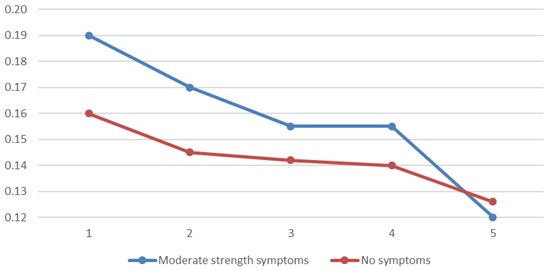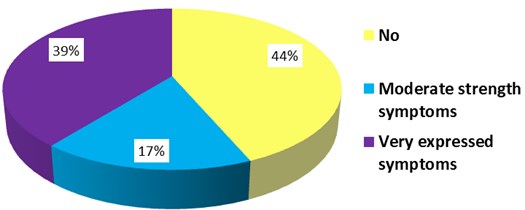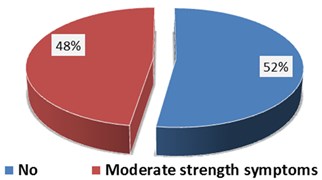Abstract
The purpose of the study was to assess the dynamic characteristics of ECG parameters while performing different genre roles played by students of the Lithuanian Academy of Music and Theatre. Discriminant of the matrix was employed to assess the strength of the relation between a pair of two parameter sequences. The results of the conducted research showed that discriminant of regulatory and supplying systems decreased at different stages of the study process. In addition, the results revealed that the average discriminant values vary greatly only in the first stage – after isometric muscle relaxation (p<0.05). No statistically significant differences were found for the rest of the stages (p≥0.05).
1. Introduction
Nowadays, actors are perceived not only as the translators of the theatre text, but also as creators relying on their imagination, improvisation and kinaesthetic perception. Acting is a phenomenon and a process – a dynamic, psychophysical, embodied and enlivening process. Also, it is an interaction between participants of a theatrical event within a specific context. Actor’s body is a multi-dimensional entrance which could be considered as a certain structure from which actor deals with the information he/she has in order to communicate to the audience by transforming it into the expression of emotions, thoughts and gestural interactions. So, the performer has to develop a heightened attunement of sensory and perceptual awareness of a certain sort in order to be fully responsive to theatrical environments and dramaturgies [1]. Acting is an art of integration of all abilities and qualities of the body including intensive circulation of energy not only on a biological dimension but also on a psychological level. Constant evaluation or judgement of the observer based on a subjective view adds pressure towards a performer and affects his/her creativity and health. Actors are especially sensitive to external factors, gradually becoming a reflection of real-life experiences, which cause different intense emotions. Emotional contexts inevitably lead towards different and complex tensions in actor’s body. Actors are confronted with double responsibility while tackling with their own personal complexity and creating an energetic body to drive complexity of the system during the act of fiction. Despite the fact that anxiety is unavoidable, the aim is to create the space of coherence between the actor’s body with artistic intention and attention that is fixed into the body sensations, through the body senses.
There are many research works that emphasize the unification of body functions [2] and demonstrate obvious benefits of complex and integrated assessments [3]. It is therefore increasingly important to carry out complex studies on the links between the physical and mental health parameters of actors and to integrate those research results into the education system for future actors, as well as to seek most optimal interventions.
The purpose of the study was to assess the dynamic characteristics of the electrocardiograms’ (ECG) parameters of students at the Lithuanian Academy of Music and Theatre, depending on their psychoemotional status while acting roles of different genre.
2. Methods
The object of the study was a group of 21 students (9 females, 12 males) of the 3rd year at the Lithuanian Academy of Music and Theatre (age interval – 21±1,9 years).
Research protocol is described as follows. ECG monitoring protocol consisted of 5 stages, each of which lasted 5 minutes: first stage – 0-5 min. (rest, post-isometric muscle relaxation), second stage – 5-10 min. (drama role), third stage – 10-15 min. (comedy role), fourth stage – 15-20 min. (tragedy role), fifth stage – 20-25 min. (rest, autogenic training). For these three different roles all participants had to present the same dialogue from W. Shakespeare‘s Macbeth.
Recording of ECG. For ECG recording the “Kaunas-Load” system, developed at the Institute of Cardiology of Lithuanian University of Health Sciences was used. It performs ECG parameters registration, initial data processing, noise filtering and recognition of ECG complexes. ECG recording of 12 leads synchronously lasted during examination time – 25 min. Two ECG intervals – RR interval (time between two heart beats) and JT interval (parameter related to metabolic speed in heart) were taken for the analysis.
Psychoemotional evaluation. Zung Self-Rating Depression Scale [4] was used to assess depression among participants. The scale is a self-administered survey of 20 questions, each measured on a scale of 1 to 4. Higher obtained scores correspond to more frequent symptoms [5].
Analysis methods. An algebraic scheme was used for the assessment of interrelations between two different physiological parameters [6, 7].
In this paper two number sequences (xj;j=0,1,...,n) and (yj;j=0,1,...,n) represent synchronous measurements of ECG parameters: RR and JT intervals are registered at discrete time intervals. The Lagrangian difference matrix is introduced in [8] and revisited in [9]. It is defined by the following Eq. (1):
The scalar characteristics of matrix Lk will reflect the algebraic interrelation between sequences (xj;j=0,1,...,n) and (yj;j=0,1,...,n). The discriminant of the Lagrangian difference matrix which is employed in this research is defined by Eq. (2) [8]:
Large discriminant values are indicating low interrelation, small discriminant values are showing high interrelation between the discussed parameters [8]. Discriminant’s mean values were calculated in a chosen time interval – 5 min, in order to summarize and smooth the estimate of interrelation in the particular interval. Sequence of those means was evaluated for every person studied (the discriminant (Disc) during different stages (see research protocol for description of the stages)).
ECG parameters selected for the research were RR and JT intervals. Interrelation between these parameters was evaluated using the discriminant Disc (RR/JT) (Eqs. (1, 2)). Statistical test for the differences between average values of the discriminants were performed by using the Mann-Whitney U test [10]. Significant differences were considered to be present if 0.05.
3. Results
Disc (RR/JT) reflects interaction between the regulatory and supplying systems in a human body [9]. The dynamics of Disc (RR/JT) were decreasing during all research stages from 1 to 5 (Fig. 1).
Fig. 1Changes of Disc (RR/JT) throughout different stages: 1-st stage – rest, before investigation, 2-nd stage performing drama role, 3-rdstage – performing of comedy role, 4-th stage – performing of tragedy role, 5-th stage – rest after examination

In terms of psychoemotional status of the participants, it was found that the mean values of Disc (RR/JT) differ significantly only in the first stage – after isometric muscle relaxation (0.05).
No statistically significant differences were found neither in the different genre roles nor while participating in an autogenous training (0.05).
The results of the questionnaires filled which addressed the participants’ level of expression of anxiety and depression symptoms are depicted in Figs. 2 and 3.
Fig. 2Distribution of the symptoms of anxiety among the subjects of the study

Fig. 3Distribution of the symptoms of depression among the subjects of the study

As it is seen in Fig. 2 and Fig. 3, more than a half of the study group (56 %) had moderate or very strong symptoms of anxiety. When examining the expression of symptoms of depression, almost half of the group (48 %) had moderate strength symptoms of depression.
Fig. 4Changes of RR interval: 1-st stage – rest, before investigation, 2-nd stage performing drama role, 3-rdstage – performing of comedy role, 4-th stage – performing of tragedy role, 5-th stage – rest after examination

During the rest in the 1-st and 5-th stages we can see longer RR intervals and shorter RR intervals during drama, comedy or tragedy roles. In the figures presented there are the average changes depicted only, but for every person those changes are different. Maybe it could be related to the aspect that every student has his/her own preferred role and for that subjectively “special” role one has more expressed reaction of RR intervals. This reflection was not studied deeper in this research.
Fig. 5Changes of JT. 1-st stage – rest, before investigation, 2-nd stage performing drama role, 3-rdstage – performing of comedy role, 4-th stage – performing of tragedy role, 5-th stage – rest after examination

As with RR interval, we can observe similar visual changes in JT with respect of different stages of the experiment (Fig.5). Shorter RR interval reveals a higher heart rate – HR. General changes of RR and JT parameters are very similar, but their interrelation differs – in 5-th stage we do not observe an increase of Disc value, but on the contrary – a decrease was revealed, which can indicate the remains of former stress which lasts longer.
Table 1Correlations between disc and anxiety, depression
Rest | Drama | Comedy | Tragedy | Relax | |
Stage | 1 | 2 | 3 | 4 | 5 |
Corr (Anx.; Disc) | 0.6404* | 0.6137* | 0.5513* | 0.2900 | 0.5514* |
Corr (Depr.; Disc) | 0.2118 | 0.4646* | 0.2832 | 0.0296 | 0.1684 |
Note: 1-st stage – rest, before investigation, 2-nd stage performing drama role, 3-rdstage – performing of comedy role, 4-th stage – performing of tragedy role, 5-th stage – rest after examination. 0.05 | |||||
4. Discussion
The purpose of the study was to assess the dynamics of ECG parameters of students at the Lithuanian Academy of Music and Theatre students while performing roles of different genre. The results of the study showed that Disc (RR/JT) decreased in the research phases from 1 to 5. There are very few research papers that discuss the state of health of artists in relation to their performances, but researcher F. Reynolds [11] says that emotions and visualizations during artistic performances are strongly associated with body reactions. In [11] it was argued that artistic activity can lead to positive physical and emotional changes if these activities cause positive thoughts, associations and images. Therefore, it can be assumed that negative imaginary experience, on the contrary, is likely to lead to negative health outcomes (anxiety, depression, apathy, etc.). This assumption was also strengthened by the results obtained when screening for the subjects’ expression of anxiety and depression symptoms. The results showed that a relatively big part of the study group had moderate or strongly expressed symptoms of anxiety and/or depression. Knowing that when a person suffers from anxiety or expressed symptoms of depression, it is more likely that he/she would delve into negative emotions and visualizations rather than positive ones, the relationship between the expression of the examined symptoms and physiological processes (in our case – ECG parameters dynamics) seem probable. There is scientific evidence that an exceptional lifestyle and self-treatment tendencies among actors put many of them at risk of drug use [12], which supports the need to investigate the reasons for their long-term negative mental state and the ways of interventions that could be taken.
This study has limitations – small sample size did not allow to examine the aspects of mental state, level of fitness, etc. in more detail.
The study opens up new opportunities for the practical application of the theory of complex systems in order to improve participants’ awareness of their dynamic health processes during various artistic performances and to propose possible interventions. Especially, interrelations between psychological and physiologic features could be seen and studied deeper using the proposed Disc (RR/JT) approach [9, 13].
5. Conclusions
ECG parameters changes during the performance of different genres. A study of actors-to-be revealed that the relationship between the regulatory and supplying systems in human body become closer during the act. When screening for the symptoms of anxiety, only 44 % of the participants did not express any symptoms. When screening for depression symptoms, the results divided the group in two almost equal parts – 48 % expressed moderate symptoms, and 52 % did not express symptoms of depression. It was found that the relationship between the regulatory and supplying systems before the investigation among the students with more expressed symptoms of depression was significantly stronger than among the students with no symptoms. After the performance we can observe a long-lasting stress effect (together with a decrease of Disc (RR/JT)). Correlations between psychological and physiological indexes could be a good measure for evaluation of students’ overloads during their study and work.
References
-
Zarrilli P. B., et al. Acting: Psychophysical Phenomenon and Process. Palgrave Macmillan, 2013, p. 1-50.
-
Smidtaite R., Navickas Z., Vainoras A., Bikulciene L., Poskaitis V. Evaluation of coherence of t-wave in different leads. Electronics and Electrical Engineering, Vol. 5, Issue 93, 2009, p. 113-116.
-
Zumbakyte Sermuksniene R., Kajeniene A., Berskiene K., Daunoraviciene A., Sedereviciute Kandrataviciene R. Assessment of the effect of anthropometric data on the alterations of cardiovascular parameters in Lithuanian elite male basketball players during physical load. Medicina, Vol. 48, Issue 11, 2012, p. 566-571.
-
Zung W. W. A self-rating depression scale. Archives of General Psychiatry, Vol. 12, 1965, p. 63-70.
-
Romera I., Delgado Cohen H., Perez T., Caballero L., Gilaberte I. Factor analysis of the Zung self-rating depression scale in a large sample of patients with major depressive disorder in primary care. BMC Psychiatry, Vol. 8, 2008, p. 4.
-
Bikulciene L., Navickas Z., Smidtaite R., Berskiene K., Vainoras A. The measure of ECG complexity by matrix analysis. Journal of Applied Electromagnetism, Vol. 13, Issue 1, 2011, p. 1-9.
-
Bikulciene L., Navickas Z., Vainoras A., Poderys J., Ruseckas R. Matrix analysis of human physiologic data. Proceedings of 31st International Conference on Information Technology Interfaces, Cavtat, Dubrovnik, Croatia, 2009, p. 41-46.
-
Berskiene K., Lukosevicius A., Jarusevicius G., Jurkonis V., Navickas Z., Vainoras A., Daunoraviciene A. Analysis of dynamical interrelations of electrocardiogram parameters. Electronics and Electrical, Vol. 7, Issue 95, 2009, p. 95-98.
-
Ziaukas P., Alabdulgader A., Vainoras A., Navickas Z., Ragulskis M. New approach for visualization of relationships between RR and JT intervals. PloS One, Vol. 12, Issue 4, 2017, p. 0174279.
-
Zar J. H. Biostatistical Analysis. Prentice Hall International, New Jersey, 1998, p. 147.
-
Reynolds F. Conversations about creativity and chronic illness II: textile artists coping with long-term health problems reflect on the creative process. Creativity Research Journal, Vol. 16, Issue 1, 2004, p. 79-89.
-
Ellias D. M. G., Berg Cross L. An exploration of motivations of fine art students in relation to mental and physical well-being. Journal of College Student Psychotherapy, Vol. 23, 2009, p. 228-238.
-
Saunoriene L., Siauciunaite V., Vainoras A., Bertasiute V., Navickas Z., Ragulskis M. The characterization of the transit through the anaerobic threshold based on relationships between RR and QRS cardiac intervals. PloS One, Vol. 14, Issue 5, 2019, p. 0216938.
